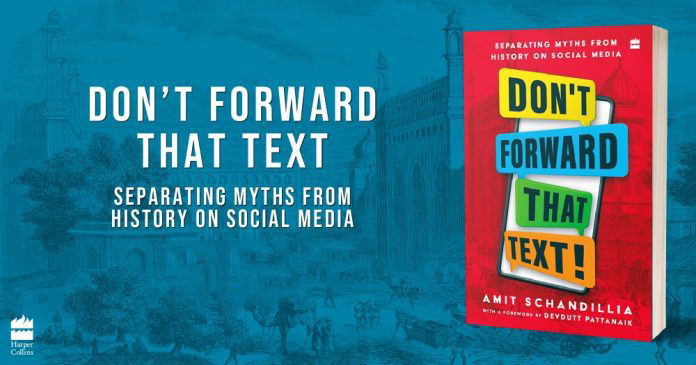
Debunking Tipu Sultan’s Hinduphobia and other WhatsApp forwards
Amit Schandillia’s book ‘Don't Forward That Text! : Separating Myths from History on Social Media’ is a well-informed response to the social media pandemic afflicting India

So, how many Hindu temples did Tipu Sultan destroy?
Many, most might answer. Innumerable, Hindu radicals are bound to assert. History communicator Amit Schandillia’s meticulous research leads to findings that are bound to shock everyone: those who view the Muslim king positively and those who hate him. These fill the pages of Don’t Forward That Text! : Separating Myths from History on Social Media.
At the height of the Maratha-Mysore hostilities in 1791, a cavalry of armed horsemen tore through the revered Sringeri shrine in modern Karnataka and plundered the premises. The chief priest or Swami was stripped of even his pitcher and walking stick, women were molested, and some people were killed. Sringeri was looted to its bones.
Also read: ‘Tipu Sultan was a barbarian’: Amit Malviya slams Owaisi for celebrating Tipu Jayanti
No wonder we hate Tipu Sultan, some might react. Hold on, the reality is not what you think happened. The priest identified the raiders. They were irregulars attached to a bigger contingent from the Maratha empire and led by, believe it or not, two Brahmins — Raghunath Rao Patwardhan and Parashuram Bhau.
What those forwards won’t tell you
The incensed Swami could not stomach the fact that a Brahmin-led band could heap such humiliation on a Hindu site. He urged Nana Fadnavis, the most influential Maratha statesman then, to do justice. Nana did not respond. The Swami then turned to Tipu Sultan since Sringeri came in his domain.
The Sultan responded immediately. He pledged monetary and material help to consecrate a new image of goddess Sharada, as the raiders had taken away the existing one. The consecration of the shrine founded by Adi Shankara was duly carried out. Tipu Sultan sponsored a Sahasra Chandi Japa, and a thousand Brahmins were hosted and offered gifts each day throughout the ceremony.
Was this a one-time act of generosity by Tipu Sultan towards a place of Hindu religious worship?
Also read: Bengaluru court vacates temporary injunction on sale of book on Tipu Sultan
No, informs author Schandillia. In 1785, he gifted a dozen elephants to the Cheluvanarayana Swami temple at Melkote. This was after sending silver utensils to the Lakshmikanta Temple in Nanjangud. The Kote Venkataramana Temple in Bengaluru received the Sultan’s patronage for the remainder of his life after it saved him once from cannon fire. He also built the Navasara Hanuman Temple on the Mysuru-Bengaluru highway. The Kollur Mookambika Temple of Udupi still performs a Salam Mangalarati every evening in memory of the day when Tipu dropped in to offer prayers and partake in the prasad. The Yoga Narasimha Temple in Melkote received a huge drum and a bell from the Sultan, who also gifted a jade linga to the Shrikanteshwara Temple in Nanjangud.
The flip side of the coin
Surprised? It is not that Tipu Sultan did not harass or kill Hindus at all. He did. When Coorg rebelled, the Sultan put it down with an iron fist, committing carnage. Hundreds were killed and thousands were taken to Seringapatam as prisoners. Many adult men among them were circumcised and conscripted into his army.
Schandillia underscores that most Tipu’s actions vis-à-vis Hindus were mere responses to immediate political imperatives rather than religious zealotry. If he was a zealot, he would not have contributed to or prayed at any Hindu temple. Indeed, much exaggeration and misinterpretation surround the narrative around the Sultan and his conduct. The author doesn’t say Tipu Sultan wasn’t Hinduphobic; but nor could one conclude that he was.
But prejudiced warriors on the social media have other ideas — and pursue a political trajectory. So, the next time you get a WhatsApp message or email informing you how anti-Hindu Tipu Sultan was, do not forward it blindly.
Also read: I-Day: Section 144 imposed in Shivamogga after row over Savarkar, Tipu banners
This book is a well-informed response to the social media pandemic afflicting India, thanks to people who are either ill-informed or who place great importance to the Hindu past but without bothering to know what is factually correct. Politicians, as they say, prefer bards to historians. Bards are only keen to rake up pride over a supposed glorious past. Pride does fetch votes.
Busting some myths
Schandillia’s research is ideology-agnostic and also indifferent to religious and political sentiments. A familiar name on Twitter, he decided to delve into Indian history after realizing that laughable conspiracy theories that could have been amusing in an earlier time were threatening to become mainstream scholarship now. In 30 well-crafted and easy-to-read chapters, Schandillia busts many myths and confirms some historical truths. In the process, many social media “facts” get punctured.
Yes, India is the birthplace of steel but it has nothing to do with Damascus steel; cotton is indeed India’s gift to the world; it is equally safe to conclude that the Indo-Aryan peoples weren’t indigenous to the Indian subcontinent; the world’s first zero did not originate in India, and when it did, it wasn’t with Aryabhata; Ujjain was not the timekeeping capital of the ancient world; Persian and Sanskrit share a common linguistic heritage; algebra does not have one inventor, and India was just one contributor; there is little to establish that a physical river named Saraswati ever washed through the Indian subcontinent; Hindus, too, have desecrated, believe it or not, Hindu temples… The book goes on and on.
Also read: Project to ‘rewrite’ Indian history a milestone in 4 decades of RSS efforts
Schandillia’s brilliant research turns many “truths” upside down. Every Indian must read this book — to confront our past without prejudice.

